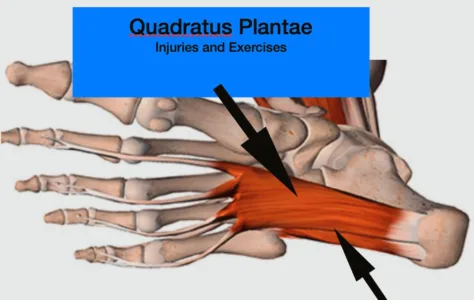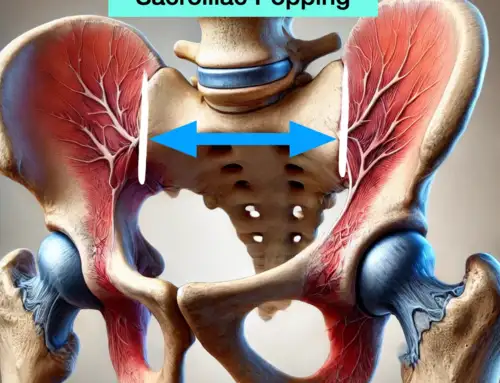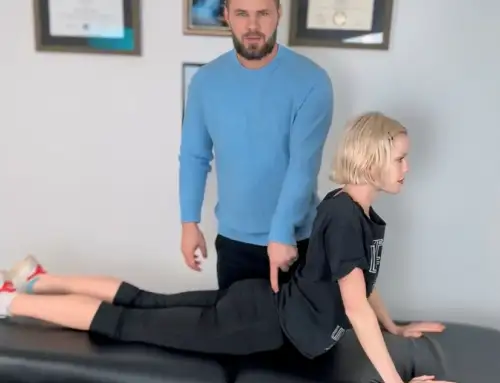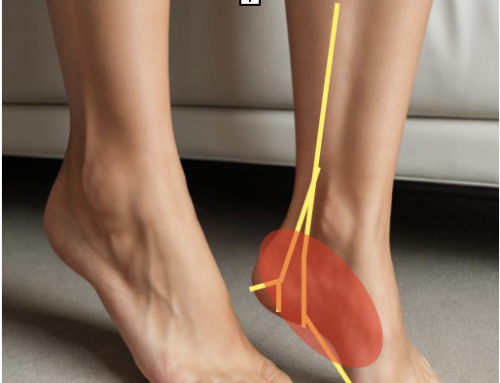The Function and Anatomy of The Quadratus Plantae Muscle: Exercises Included
 The quadratus plantae muscle, also known as the flexor accessorius is a foot muscle that supports the arch and stabilizes the toes while walking. It plays a role in maintaining foot mechanics and preventing injuries associated with overpronation or flat feet.
The quadratus plantae muscle, also known as the flexor accessorius is a foot muscle that supports the arch and stabilizes the toes while walking. It plays a role in maintaining foot mechanics and preventing injuries associated with overpronation or flat feet.
This blog is a 2024 update to the best exercises selection
Abbreviation; QP
Function of this Foot Muscle
The muscle lies deep in the foot beneath the flexor digitorum longus muscle. It originates from the lateral tubercles of the calcaneus (heel bone) and travels towards the tendons of the flexor digitorum longus, running parallel and eventually blending into the tendons.
Despite being small, the QP muscle plays a role in foot mechanics. It assists the FDL in bending the toes for gripping surfaces during activities like walking, running, and climbing. Additionally, it contributes to stabilizing the foot arches and foot muscles, preventing pronation or supination during weight-bearing tasks. The muscle also aids in proprioception, enhancing balance and coordination.
Moreover the QP muscle supports the arch of the foot acting as a shock absorber and reducing the risk of soft tissue injuries. It assists the surrounding muscles and structures, within the foot to maintain stability and fine tune movements for function, due to the insertion points on tendons rather than bone. This allow for precision when bending toes or grabbing marbles.
Common Injuries and Conditions That Impact the Quadratus Plantae Muscle
While injuries to the Quadratus Plantae (QP) muscles are less common, they usually occur with a weak or poorly functioning foot.
Strain or Overuse Injury: The QP muscle can experience strain or injury due to excessive use or sudden spikes in physical activity levels. This is common with runners and weekend warriors. Dancing and jumping are also risk factors.
Plantar Fasciitis: Although plantar fasciitis primarily involves inflammation of the plantar fascia (a band of tissue along the sole of the foot), it can also impact the QP muscle due to the muscle being just on the underside of the structure. The two injuries go hand in hand and can work to exacerbate both if tightness or dysfunction occurs in either.
Muscle Imbalance: Disparities in foot and lower leg muscles can result in movements and increased stress on structures, including the deep muscles.
Muscle weaknesses or tightness, in areas might make the QP muscle work harder than necessary increasing the chances of strain or injury. Modern shoes contribute due to not allowing the foot to spread out during locomotion.
Foot Arch Problems: flat feet (pes planus) or high arches (pes cavus) may experience changes in biomechanics that put pressure on the QP muscle. Flat feet can lead to overpronation while high arches may cause supination both of which can impact how the QP functions. How well a person controls foot motion is more important than the height of the arch. Many african elite runner’s have completely flattened feet, but are the motion is well controlled and thus less injury prone compared to a poorly controlled foot.
Footwear Issues: Shoes that are too tight such as highheels can limit foot muscle movement while those lacking support might strain the flexor accessorius and other intrinsic foot muscles. Overtime the foot weakens due to inability to spread the foot and utlitize the full muscle capacity of the foot.
Direct Impact: Sometimes direct trauma to the bottom of the foot from activities like sports or a kick can result in QP muscle injuries. This could lead to bruising, inflammation or even muscle tears depending on the specifics of the impact.
Repetitive Strain: Certain jobs or activities involving prolonged standing on surfaces or repetitive foot movements may cause stress, on the quadratus muscle. Over time the consistent strain can lead to injuries and strains. This is one of the reasons why grocery clears have the soft mats.
Incorrect Body Mechanics: Any deviation, from foot mechanics like much inward or outward rolling of the foot or walking on tiptoes (cerebal palsy) can disrupt the natural function of the quadratus plantae muscle. Likely due to a over contraction (tip toes) or under contraction of the muscles (foot collapse). Poor body mechanics could be a result of muscles, stiff joints, or structural irregularities in the foot.
Exercises to Strengthen and Stretch the QP Muscle
Towel Toe Curls: Sit on a chair with your feet flat on the floor, then grab the towel with your toes like fingers. Repeat this for 2- 3 sets of 10-15 reps.
Toe Spread: Stand or sit with your feet flat on the floor. Splay the toes apart to your capacity, and release. Do this exercise for 2- 3 sets of 10-15 repetitions to regain full function of your toes. Advanced exercise is setting one toe down at a time like playing a piano.

Marble Pickup: Use your toes to pick up one marbles and put them in a bowl. There should around twenty marbles. Cramping is normal.
Do 2-3 rounds of 10-15 reps each.
Stretching the Plantar Fascia: Sit on the ground with one leg stretched out in front of you. Use a towel around the ball of your foot. Pull backward until you feel a stretch in the bottom of your foot and calf. Hold this position for 20 to 30 seconds before switching legs. Repeat this stretch on each side 2 or 3 times. By stretching the plantar fascia, you indirectly help release tension in the foot muscles.
Calf Stretch while Standing; Stand facing a wall with one foot behind the other. Lean forward while keeping your back leg straight and your heel planted on the ground until you feel a stretch in your calf and underfoot area. Hold this stretch for 20- 30 seconds before changing legs. Repeat this stretch on each side 2 -3 times.
Stretching the muscles in your calf can help relieve tension in your feet.
To strengthen your arch using a Theraband:
- Sit on a chair with both feet flat on the floor.
- Wrap a resistance band around the ball of one foot.
- Hold the ends in your hands.
- Press your foot down against the band’s resistance while keeping your toes flat on the ground to engage your foot’s arch.
- Hold for 5 -10 seconds, then release.
- Repeat this exercise for 2 3 sets of 8 10 repetitions per foot.
To strengthen your foot muscles, sit or stand with flat feet on the ground. Lift your toes off the ground while keeping your heels down for 5 -10 seconds, then lower them down. Perform this exercise for 2 to 3 sets of 8-10 repetitions.
Try out toe yoga by sitting with both feet flat on the floor. Lower each toe individually to improve dexterity and strength. Aim for two to three sets of 10 to 15 repetitions to reap its benefits.
To massage and relax your foot arch, sit on a chair. Roll a tennis ball under it.
Remember to roll the ball forth from your heel to the ball of your foot, exerting light pressure. Focus on any areas that feel tense or uncomfortable. Repeat this massage technique for 1 2 minutes on each foot to help release tension in the foot muscles, mainly targeting the muscles.

The exercises and stretches above address many of the deep muscles of the feet and can be used as a general foot rehabilitation program.
Manual Therapy
Due to repetitive overuse activities, the QP fascia can become stiff and dehydrated. Muscle scraping of the foot’s arch can help relieve pain and regain foot function.

Clinical Pearl
In any lower extremity condition, the lower back needs to be evaluated for possible referral to the foot. Not every perceived foot problem originates in the foot.
Our editorial guidelines prioritize evidence-based practices, interventions, and recommendations.
Reach out to Dr. Dean (sports chiropractor) by texting (best), calling 323-354-6077, or emailing at drjustindean@gmail.com
Our editorial practices include evidence-based practices, interventions, and recommendations.
References







